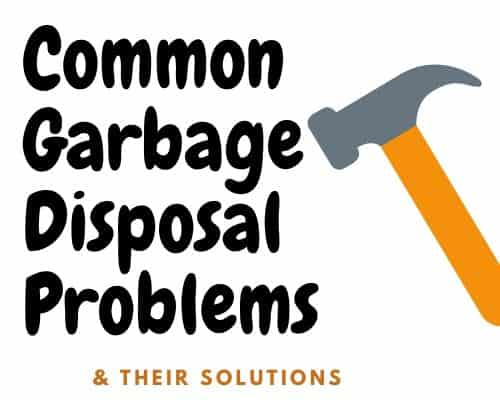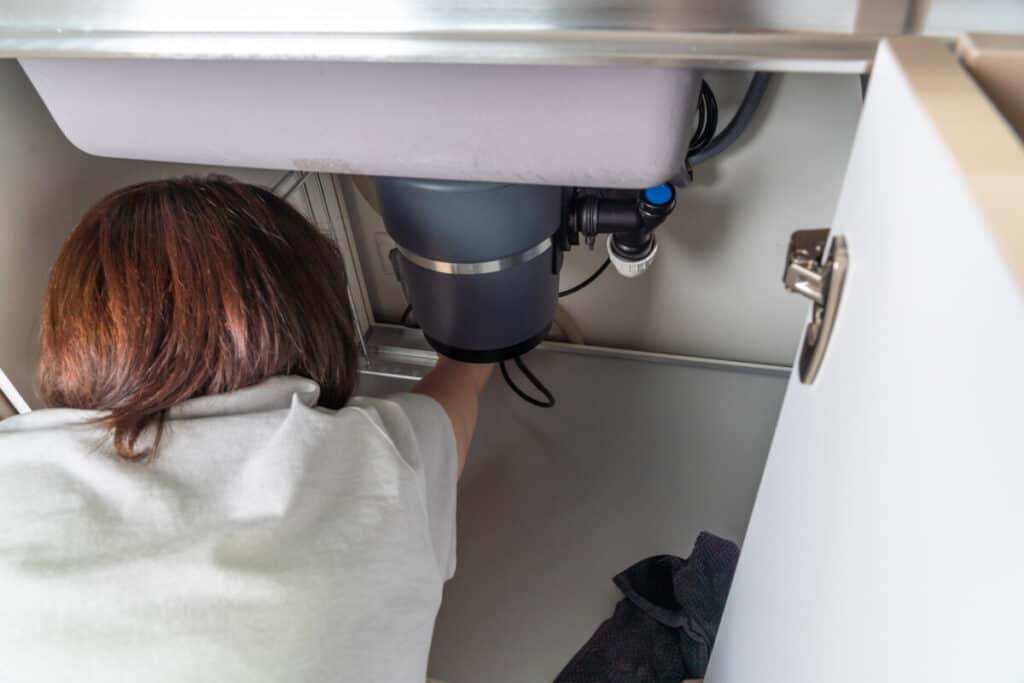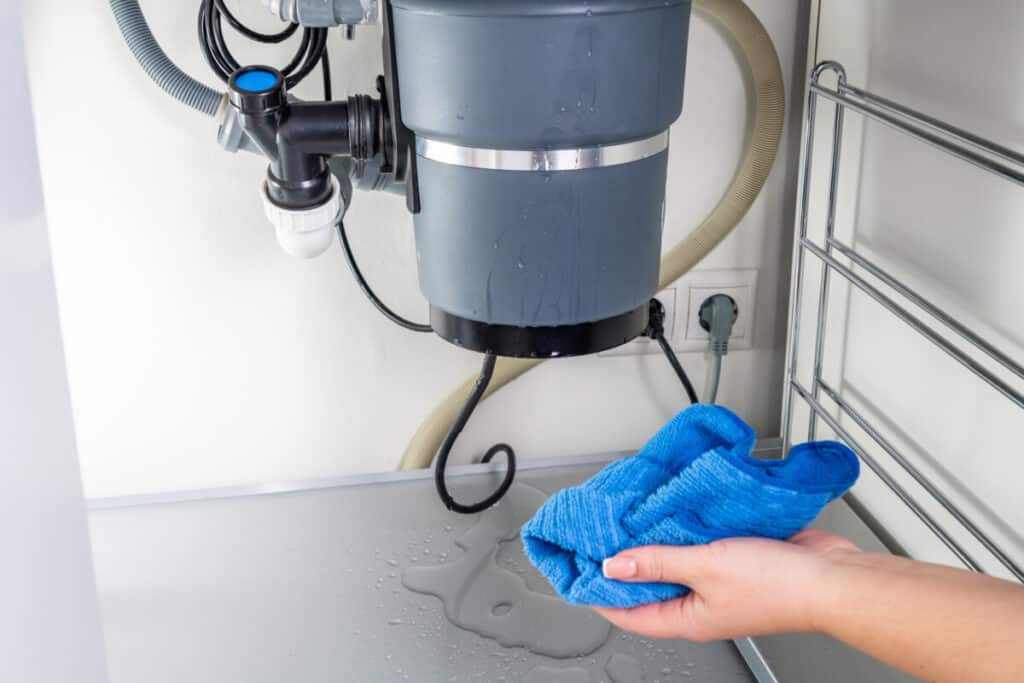
Garbage disposals are one of those modern conveniences we often take for granted until they break. Few things can turn a good day into a bad day like a garbage disposal that stops working. It can be especially distressing when you don’t know what’s wrong with it.
Whatever problem you’re running into, we can help you fix it! With the help of this article, you can solve most problems garbage disposals often have.
1. Humming Sound but Isn’t Working
You finish your delicious meal, rinse off your plate, stick it in the dishwasher, and then run the disposal. All you get is a mild humming noise, but the blades are not grinding up what’s left of your parmesan chicken. What’s wrong with the garbage disposal?
The humming sound means that the garbage disposal is turned on, but the plate isn’t moving. If the garbage disposal is on but not spinning the plate, this means that it’s not getting enough power or something is jamming it. There are simple ways to fix both problems.
- Diagnose the Problem: First, you’ll need to determine what the problem is. When the garbage disposal is turned off, reach a pair of kitchen tongs down and feel around for food and debris that could be stuck in the grinder. It will probably be helpful to remove all the parmesan chicken too (or any food that may be at your disposal), just to make sure you have everything. Run the disposal again. If the same problem occurs, you probably have an electrical issue. Remember, never put your hand in your garbage disposal! Even if it is completely turned off.
- Reset the Disposal: Once you know there isn’t any food stuck in the main cavity, you can move on to discover the source of the electrical problem. First, start by finding the reset button on the bottom of the disposal. Push this button and wait a few moments. Run the disposal again. The power to the disposal should be back on again.
- Call for Help: If you don’t find anything blocking the grinder and if the reset doesn’t work, there’s probably another problem that only an expert and handle. Give the disposal one last check and then call for help. It could be that your garbage disposal has lived its life and needs to be replaced, but a good repairman will be able to identify and fix the problem.
2. Won’t Turn On
If your garbage disposal isn’t working, it can lead to worse issues than not having a way to grind up the remnants of dinner. Your garbage disposal is linked to your dishwasher and sink. If the disposal isn’t working, it could lead to backed-up pipes in other places.
When the garbage disposal doesn’t turn on, there is a problem with the motor or the electricity. Other causes could be overheating or overloading as garbage disposals can be overworked. To fix this, check the overload protector and the electrical connection. Turn off the electricity beforehand.
It is relatively easy to fix your garbage disposal if it won’t turn on. However, if it doesn’t turn on, and you can’t find the reason why it’s not working, call a professional.

- Check Overload Protector: On the bottom of your garbage disposal under the sink, you should see a red button. If it is lowered a quarter inch or so, that means the overload protector has been tripped. It does this to prevent your disposal from damaging itself by working too hard. Push this red button in gently. If it doesn’t stay in, that just means your disposal needs more time. Try again in ten minutes or so.
- Check Electrical Connections: There are several places where electricity could be stopped. Start with the circuit breaker. If it’s been tripped, switch it back into place and try running the disposal. If that didn’t work, try checking the wall switch for loose wires. For safety, make sure all power in the area is switched off. All wires should be secure, including those attached to the bottom of the disposal.
- Call a Professional: If you can’t find and fix the problem, it’s time to call a garbage disposal repairman. They can diagnose and solve most disposal problems, and it is often safer and easier to let them do their job, although it can be expensive. There are some occasions when the garbage disposal is unrepairable, but the professional will be able to determine when that happens.
3. Smoking
Yikes! There’s smoke seeping out from under your sink! Smoking kitchen appliances are never a good sign, but you probably didn’t expect to find one under your sink. Your garbage disposal seems to have turned into a dormant volcano, what are you going to do?
A smoking garbage disposal is a symptom of a fried circuit or motor. Usually, that just means your disposal is working too hard and the circuit is now broken. If you hear a humming sound from your garbage disposal while it is smoking, turn it off immediately and start looking for a new disposal.
If your garbage disposal is smoking, there’s not much hope for repair, but you can try the following:
- Disconnect Disposal: Unplug and unscrew the disposal from the sink and its power source. Open the bottom part of the disposal and check the wiring. If it’s the motor that’s burning, you should probably resign yourself to buying a new disposal. If it’s not the motor, then it’s probably one of the wires.
- Rewire: After finding the wire that needs attention, you can reconnect it properly. If you’re unsure how to do this, you can find lots of online tutorials, but it’s often best to call a professional or buy a new disposal. Chances that the smoke was caused only by a burnt wire that is hard to replace.
4. Leaking
A leaky garbage disposal is a giant messy curveball in your day. Get out some towels and a bucket while you try to fix it and try not to get too wet. It might look like a huge problem, but you probably don’t need to call a technician just yet. Most leaking garbage disposals can be solved by you, even if you don’t have any experience repairing disposal.

Common causes of leaky garbage disposals involve an improper connection or internal damage of some kind. If your disposal is leaking from the top of the sides, you’re probably dealing with some misaligned seals. If the leaking is coming from the bottom of the garbage disposal, it is damaged.
Unfortunately, if your disposal leaks from the bottom, it is too damaged to repair. If that is your situation, you should just buy a new garbage disposal. If not, here’s what you can do to fix your leaky garbage disposal:
- Leaking from the top: First, find out what parts are faulty and causing the leak. Disconnect the disposal from the drainpipe, then completely remove it from under the sink. Next, examine the sink flange, gasket, and sealing putty. If any of these parts are damaged, they will need to be replaced.
- Leaking from the side: Locate the source of the leak—the drainpipe or the dishwasher connector. For either side, disconnect the pipe and clean it thoroughly. On the dishwasher side, reconnect with a secure clamp. On the drainpipe side, you might need to replace the rubber gasket.
For both solutions, using a healthy amount of plumbers putty can go a long way to seal up the pipes and prevent any future leaks.
5. Clogged
Filmy water has filled up your sink, and running the disposal does nothing to help. How in the world are you going to get rid of all this water?
When a garbage disposal is clogged, there is a blockage in the drainpipe or the garbage disposal chamber. Use a sink plunger to dislodge the clog from the drainpipe. If the clog is in the disposal chamber, shift food until it breaks up and can be broken down when the disposal is run.

Not sure how to plunge your sink? Here’s how it works:
- Seal the Plunger: Place the lips of the plunger over the drain opening. It’s important that it is tightly sealed to create the right amount of suction.
- Plunge: Gently but firmly pump the plunger up and down to suck the material causing the clog back up and out of the pipe.
- Rinse: When the water in the sink starts to drain, turn your faucet on hot and let it run for a few moments. Then turn the disposal on so it can clear away the last bit of debris.
Remember, not all plungers are the same. Some are designed for sinks and some are designed for toilets. Make sure you get a sink plunger to achieve the proper seal, one that looks like this.
6. Sink Won’t Drain
Sometimes your disposal works fine, but for some reason, your sink won’t drain unless you’re running the disposal. It doesn’t matter how little food is in the sink, it won’t drain on its own. This isn’t just an inconvenience. It can also mean something else is going on.
When a sink won’t drain unless the disposal is running, it usually means there is a clog in the pipes. To fix this, you can physically remove whatever is causing the blockage. This process can get messy, so don’t forget to get a bucket and some towels to catch water.
- Remove the P-trap: Underneath your sink, there is a pipe that curves like a “u.” This is called the p-trap. Carefully remove the pipe segment over a bucket.
- Clean P-trap: Using a plumber’s snake, push the debris out of your p-trap and into your bucket. Use hot water to give it a thorough wash.
- Clean Pipes: Now use the plumber’s snake to push and pull debris out of the rest of your pipes. Thread the snake back up toward the garbage disposal, then pull it back. Then do the same with the pipes leading into the wall.
- Replace P-trap: With that done, you should be safe to reattach the p-trap. Run the hot water for a few minutes to make sure the sink is now draining properly.
7. Backed-Up Disposal Affecting Dishwasher
Another modern convenience we tend to take for granted is a dishwasher. Imagine what it would be like to have to wash all your dishes by hand! Your dishwasher drains into your garbage disposal, so it’s very important to have a fully functioning garbage disposal if you intend to use your dishwasher.
If the garbage disposal is clogged or backed up, the dishwasher will not drain properly. To continue using your dishwasher as normal, the garbage disposal needs to be un-clogged. Use a sink plunger or drain snake to dislodge the clog, and the dishwasher will drain properly.
- Clear Immediate Debris: Sometimes the clog can be as simple as reaching into the disposal with a pair of tongs and pulling out food that has been keeping the blades from spinning. If your dishwasher is having noticeable trouble, however, your problem probably goes further.
- Plunge Disposal: Using a sink plunger, seal the drain opening in your sink and pump the plunger several times. Run the hot water for a few minutes after each set of 6-8 plunges. Watch to see if the sink drains. If it doesn’t, keep using the plunger until it does.
- Run Disposal: Once you’ve cleared your disposal of debris using the plunger, run the disposal for a minute or two while running hot water through it. If everything runs smoothly, you should be able to run your dishwasher without a problem. If you’re still having trouble, call a plumber.
A clogged, broken, or malfunctioning disposal can seem like the end of the world in the midst of a hectic and busy schedule. However, most garbage disposal problems can be solved fairly easily. All it takes is a few simple tools and some patience.
If you need any assistance with your garbage disposal, it’s always a good idea to call a professional. Many problems can be easily fixed at home, but sometimes a professional needs to be called to fix the problem quickly and correctly.
Related Topics:
If you like the article above, here are some other similar articles you should check out!
Garbage Disposal Cost (Disposal+Accessories+Installation)
